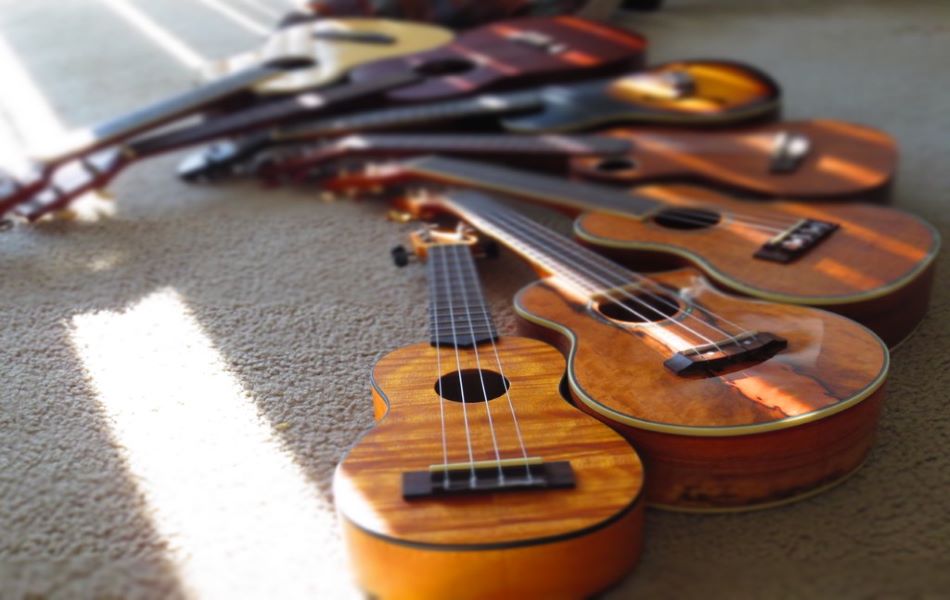The ukulele is a fun instrument with a carefree and joyful sound. Its compact size makes it easy to carry and it is loved by all ages. It is not difficult to play and master this instrument, but it will be a bit confusing for newbies. Don’t worry, in this article, we will teach you the basics of playing the ukulele.
Contents
Choosing a Ukulele That’s Right for You
The first and most important step to playing ukulele is to get a ukulele. To choose a ukulele that is right for you and your needs, there are a few things you need to consider: the size and tone of the ukulele, and your budget.

Size & Tone
Ukuleles come in a variety of sizes — and each one has its own distinctive tone:
- Soprano: This is the smallest ukulele size, including 12-15 frets. It has a higher, lilting tone compared to its larger cousins. This type of ukulele is suitable for young learners or players with small hands.
- Concert: It is larger and has more frets than a soprano ukulele. A concert-sized ukulele has a warmer and deeper tone than a soprano.
- Tenor: The largest of the most common size of ukuleles, the tenor ukulele has a rich tone and is suited for players with larger hands. Its larger size gives it a fuller, bigger sound and deeper bass tone.
See more about types of ukuleles in the article “Types of Ukuleles”
Budget
The ukulele is one of the most affordable musical instruments available, ranging from a few tens of dollars to a few hundred dollars. Similar to other musical instruments, the better the material, the higher the finish, the more expensive it is. You get what you pay for, so don’t spend money buying a cheap guitar of poor quality. It tends to break quickly and quickly get out of tune. Invest in a guitar that’s made of good materials and has a certain finish. You can get a good beginner ukulele for around $100.
How to Hold a Ukulele
Before you strum your first chords, make sure you’re holding the ukulele correctly.

Keep the back of the ukulele pressed close to your chest, nestling the body of your instrument with your right arm. This position will allow you to comfortably use your right hand for strumming. Use your left hand to hold the neck of the ukulele. Use the thumb of your left hand to support the back of the ukulele’s neck. This leaves the other four fingers free to play the strings. Left-handed players can also choose to flip the instrument so that the right hand is used for holding the instrument’s neck and the left hand is used for strumming.
How to Tune a Ukulele
Tuning a uke properly is one of the first and foremost skills that any musician has to learn when starting to play this fun instrument. If the uke goes out of tune, it’s not going to sound right.

A ukulele is tuned GCEA – from low to high. Click on the How To Tune A Ukulele article to learn how to get your guitar tuned.
Purchase our Guitar Tunio Pro plan to use the ukulele tuner and experiment with alternate tunings. Available on the App Store and Google Play.
Ukulele Strumming Patterns
The tone of the ukulele changes depending on how the strings are strung. For example, if you strum your thumb down, the sound will be smooth and mellow. However, rattling the thumbnail up makes the sound sharper and brighter. Also, how many fingers you use to strum is important. Strumming multiple fingers makes it sound like multiple people playing at the same time. A simple strumming pattern to practice is not just strumming the strings, but strumming the strings first and then back while holding the same chord. You can use a ukulele pick to strum or pluck the strings instead of just using your fingers.
How to Play Ukulele Chords
Some simple songs on the ukulele may require only two or three chords to play. Practice mastering basic ukulele chords such as the C, Am, and F chords, and start to expand the number of chords you know. Check out our 12 Basic Ukulele Chords For Beginners article to learn basic uke chords.
Learn Songs on the Ukulele
As a newbie, you should choose songs that don’t use too many different chords to learn and practice. It’s best if you’re already familiar with all the chords used in the song.

Remember that even if your favorite song is not written for the ukulele, chances are good that someone has created chords or ukulele tabs for the song. The internet has plenty of ukulele chords and tabs available for free. You can also check out how to play the chords of many great songs on the ukulele on our blog.
